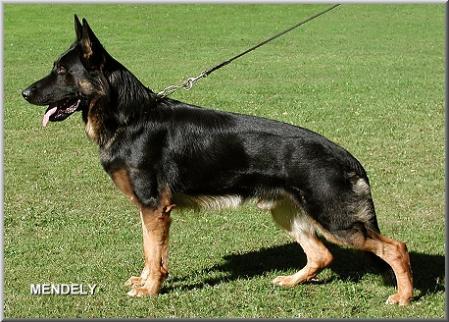
This is a placeholder text
Group text
by harddawg on 25 December 2007 - 19:12
by anand v on 26 December 2007 - 04:12
thanks for your input louise
i have to learn a lot.
by Preston on 26 December 2007 - 04:12
Louise, I am well aware of the double handler's effect on posing a GSD. Most American Shepherds are hand posed (stacked) in a bridged stance (like a rocking horse with the front lower legs forward at their base, or some the opposite with the front legs forward at their top. Yes even a well proportioned GSD can get into this pose naturally once and awhile. What I prefer is the GSD that almost always just walks into the pose I describe (seen in the weltum puppy and the dog just above posted by harddog. The early GSDs of Capt. Von Stephanitz were the type that walked into a natural stance with the lower front legs facing forward at their upper part, accompanied by a shallow chest with forward placed upper arm, and sternum (now viewed as very incorrect, and epitomizwed in the typical AKC American Shepherd). Over the years Capt. Von Stephanitz was selecting GSDs away from this more in line with my preference. His biggest problems were soft backs at the end of his reign in my view. One can examine the many GSD Siegers and Siegerins over the years to se the gradual changes toward the type I advocate (up into and throughout the 1980's). A longer GSD has some advantages moving because length helps to balance out any incompatibility between the front and rear actions, but their is a cost--less efficiency. A shorter backed dog transmists power and drive much better if he has good balance between the front and the rear (for one example of many possibilities, if his croup is not too steep, or if his rear is not sickle hocked which can cause an overly long rear stride with increased weakness and hocks that won't open). There have been a lot of back problems in GSD, especially weak or sagging backs and roach backs were selected to compensate for this and too much length (eg the Rolf Onsnabruckerland issue). One back problem which is not a roach problem and is never talked about openly is the upper facing Vee or hump back problem. This is the GSD that when standing around has a hump or Vee centered in his back that in many cases relaxes down to a normal slight roach when the dog is moving. In mild form this seems to be okay. But in some it is a serious fault if pronounced.
by harddawg on 26 December 2007 - 06:12
This dog I posted above is
V Falk von den Wölfen.
http://www.pedigreedatabase.com/gsd/pedigree/123666.html
 V rated, 3x at the BSP, rated kkl 1 and has produced nicely so far.
Many of his progeny are top competitors in the sport.
Notable entries include;
Karat vom Petersbrunnen http://www.pedigreedatabase.com/gsd/pedigree/523509.html
and
Falko vom Wolfsblick http://www.pedigreedatabase.com/gsd/pedigree/429575.html
V rated, 3x at the BSP, rated kkl 1 and has produced nicely so far.
Many of his progeny are top competitors in the sport.
Notable entries include;
Karat vom Petersbrunnen http://www.pedigreedatabase.com/gsd/pedigree/523509.html
and
Falko vom Wolfsblick http://www.pedigreedatabase.com/gsd/pedigree/429575.html
 V rated, 3x at the BSP, rated kkl 1 and has produced nicely so far.
Many of his progeny are top competitors in the sport.
Notable entries include;
Karat vom Petersbrunnen http://www.pedigreedatabase.com/gsd/pedigree/523509.html
and
Falko vom Wolfsblick http://www.pedigreedatabase.com/gsd/pedigree/429575.html
V rated, 3x at the BSP, rated kkl 1 and has produced nicely so far.
Many of his progeny are top competitors in the sport.
Notable entries include;
Karat vom Petersbrunnen http://www.pedigreedatabase.com/gsd/pedigree/523509.html
and
Falko vom Wolfsblick http://www.pedigreedatabase.com/gsd/pedigree/429575.htmlby harddawg on 26 December 2007 - 06:12
Reminds me of one of his forefathers that I also love...
Bernd vom Lierberg
VA SCHH3 (V-BSP) FH Kkl 1
 http://www.pedigreedatabase.com/gsd/pedigree/187.html
http://www.pedigreedatabase.com/gsd/pedigree/187.html
 http://www.pedigreedatabase.com/gsd/pedigree/187.html
http://www.pedigreedatabase.com/gsd/pedigree/187.htmlby harddawg on 26 December 2007 - 06:12
The "Golden Middle" in my opinion.
by Louise M. Penery on 26 December 2007 - 07:12
Preston, I guess we are simply not on the same page about some minor structural features. For example, you posted elsewhere a remark that a short croup negatively impacts the gait by providing a shorter lenghth of pelvis for the attachment of muscles in the rear legs.
However, I find it curious that Linda Shaw wrote (in one of her well-illustrated articles in the Schutzhund USA magazine) that a shorter croup (with a correct lay) provides a gait which is equally correct as that of a dog with a longer croup (also with a correct lay)
While your may not have been in the breed as long as I have (since 1964), I'm sure that you will concur that the two above photo contributions of harddawg are of dogs having somewhat longer backs because of excessive length of the loin. Also, the second dog tends to have a short, steep croup.
by Ilse on 26 December 2007 - 14:12
Preston , your dog is much better then the other 6 month on the picture
by marci on 26 December 2007 - 18:12
I'd openned this conformational topic before..."Why the croup needed to be long.???" (i think its the second conformational difference between Working and Show-lines, other than the straight-back issue..)
And yes there is only slight difference in gait provided the croup angulation is correct.... My question which is still left UNANSWERED is "Why you cant see prominent WITHERS nowadays.???" The lengthening of that back is also due to a lack of a high wither...
Contact information Disclaimer Privacy Statement Copyright Information Terms of Service Cookie policy ↑ Back to top





